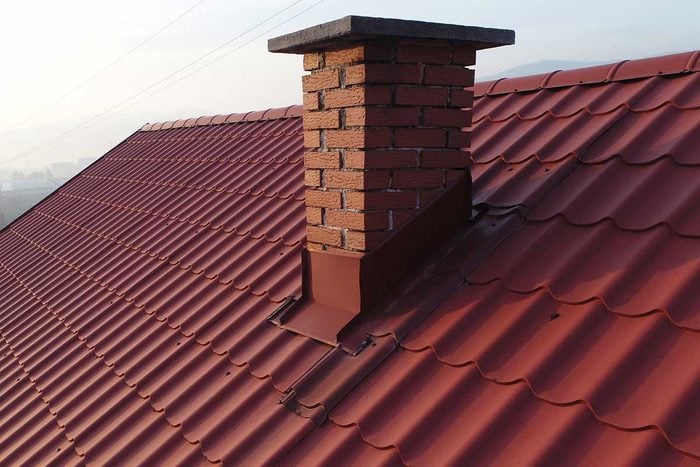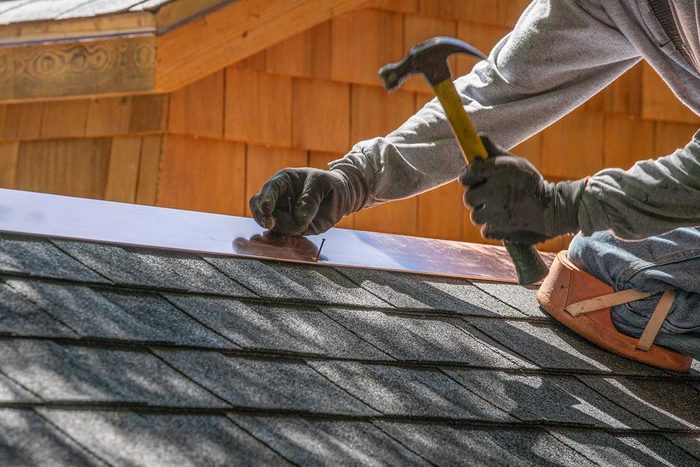Mow Your Lawn Before the Roofing Crew Arrives
Roofing is a messy job. Roofers typically work at a fast pace to minimize the amount of time it takes to remove your old roof and install the new one, so your home doesn’t go too long without the protection of that final layer of roofing material. This means that debris will fall off the roof and land on your lawn, especially around the perimeter of your home. These tarps also act as a smart temporary solution to dealing with damaged rooftops.
A good roofing crew will typically sweep the property with magnetic brooms once the project is complete to make sure no nails or off cuts are left behind, says David Steckel of Thumbtack, a service that matches homeowners with home improvement professionals and service providers. Having freshly-trimmed grass will make it easier to collect that debris and ensure they don’t accidentally leave you with any surprises.
It’s Worth Springing for Long-Lasting Materials
If you are hoping to reroof your home now and never again, a metal or slate roof might be your best bet. According to the National Association of Home Inspectors, a metal roof will last up to 80 years, while a slate roof is good to go for 150. For concrete, you should get 100-plus.
And roof life is just one benefit to using these types of materials. They also have tremendous sustainability benefits, says Josh White, president of Hoosier Contractors, a roofing company in Indianapolis.
“Most of these materials are eco-friendly and lessen the amount of water and energy usage inside a home compared to a conventional roof,” White says, adding they also enhance in-home air quality.
The downside? The longer-lasting materials are also the most expensive. Slate, for example, can cost up to $45,000 for the average home.
There Are Ways To Cut Costs
Roofing materials aren’t like fashion trends. Last year’s shingles aren’t out of style because they were manufactured last year. They aren’t subpar, either.
However, they do tend to be less expensive, White says, and using them can sometimes knock the price of your project down quite a bit. He suggests informing your roofer that you are interested in past-season materials so that they can check with their suppliers about procuring them on your behalf.
Another way to save money? Flexibility. Roofing contractor sometimes provide a discount to customers who are understanding about the occasional need to change the schedule, White says.
Always Get More Than One Quote
When you have great rapport with the first roofer that shows up to bid on the job, it can be tempting to just go ahead and sign the contract, especially if the price seems right. (FYI: The national average for a 1,600-square-foot roof is $5,148, according to roofcalc.org.)
And while you may end up hiring that roofer anyway, it’s advisable to talk to more than one pro before making a decision, says Steckel. He recommends getting two or three quotes.
Cost, of course, is a major consideration. But you should also make sure the roofer is licensed if that’s required by your state, bonded and insured. Other important factors include reputation (check online reviews and ask for references) and whether the crew has experience with the type of roofing materials you want to them to use.
Plus, you won’t really know if that first quote is even remotely reasonable unless you compare it quotes from the competition. Finding a trustworthy roofer to provide the type of roof you want is just as important, if not more so, than saving a little money, says White.
“Many (homeowners) look for the company that offers the cheapest price for the service they need or for the shortest project timeline,” he says. “While these options would conceivably help their budget in the beginning, this lack of research and thoroughness could lead to the hiring (of) an ill-prepared company, which could lead to a poorly done job … and eventually more money coming out of (your pocket) in the end.”
Spring Is the Busiest Season
If you call a roofer in April, don’t be surprised if you have to wait several weeks for a quote. White says roofers are typically slammed with projects in the spring.
He advises calling around for bids in late summer to mid-fall, so you can get on the schedule before the next busy season rolls around. This is especially important if you’ll be filing a homeowner’s insurance claim for roofing repairs, he says. The extra time will enable you to get all the insurance business sorted out and finalized before the physical repairs begin.
Your Landscaping May Be Damaged
Pro roofers usually do what they can to minimize damage to your flower beds, trees and lawn during a project. However, because the crew needs to place ladders all around the perimeter of your home, it’s likely that some damage will occur, Steckel says. He advises telling your roofing crew which areas require special care — your prized roses, for example — so they can be extra cautious while working in that area.
If potential landscaping damage is a deal breaker for you, Steckel says you can ask your roofer to cover your plants and landscaping with a tarp. Be aware, however, that there may be an extra cost. The tarp also should be removed daily after the crew is finished so your plants get some fresh air.
Staples Are Illegal in Some Places
When considering which roofing company to hire, ask if they use nails or staples. Depending on where you live, using staples for roofing might actually be prohibited by law.
And even if they aren’t illegal in your jurisdiction, nails are still the preferred choice. Why? Though roofers have long considered staples easier to work with, nails and nail guns offer far superior results. It’s much easier to drive a nail in straight, which leads to a more secure hold.
Climate Should Dictate Material
You may love the aesthetic of asphalt. But if you live somewhere with extreme heat, like Texas or Arizona, you may have to settle for metal, slate, ceramic or concrete.
“Asphalt does not function very well in extreme [heat] and it will deteriorate much faster when installed in the wrong climate,” Steckel says.
However, if you live somewhere cold, like Alaska, North Dakota or Minnesota, you’re in luck with roofing options. Most standard materials will do just fine. Discuss this with your roofing contractor to be sure, of course.
If you like the look of wood roofing, it may be viable. Just understand that wood is susceptible to mold and fire, so it’s best to avoid if you live in an extremely wet area or a region prone to forest fires.
Roofers Shouldn’t Work in Extreme Heat
Your roofing contractor said they were going to arrive at 7 AM and work all day, but they didn’t come back after lunch. What gives? Well, you might want to step outside or check any of the weather apps on your phone. If the temperature is above 90 F and/or it’s extremely humid, it isn’t safe for them to be on the roof.
Remember, heat rises, so it will probably be even hotter on the roof than on the ground. Add in black or metal roofing materials, and things get truly hazardous. A crew working on a roof on a super-hot day risks dehydration, headaches, nausea and a whole host of other symptoms. That can lead to dizziness and/or fainting, and ultimately a fall.
Bottom line: If you notice your roofing crew taking a break from the heat, relax. That’s normal.
Roofing Is a Job for Skilled Professionals
You’ve seen your neighbor do it, and you watched a YouTube video that explained how to reroof a house. As a seasoned DIYer, surely you are up to the task, right? Unfortunately, that’s probably not the case. Roofing is one home improvement project that’s typically best left to the experts.
“There are many safety precautions required to safely work in a roof,” Steckel says. “Most homeowners won’t have the safety equipment to tie themselves off or maintain a safe working environment.” There’s also potential for making the problem worse.
However, there are minor roofing repairs you may decide to take on yourself, such as patching a superficial hole in a shingle or replacing vent flashing. Whatever the roofing job, do your homework and be sure you understand all potential drawbacks and risks. Get an experienced helper, a sturdy ladder with firm footing, a safety harness and a permit, if needed. And stay safe up there.










